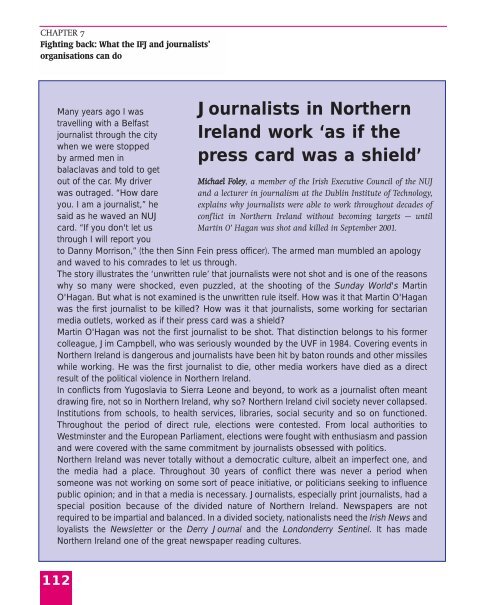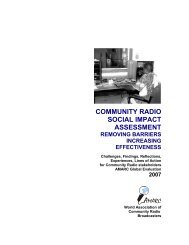Live News - A Survival Guide - International Federation of Journalists
Live News - A Survival Guide - International Federation of Journalists
Live News - A Survival Guide - International Federation of Journalists
- No tags were found...
Create successful ePaper yourself
Turn your PDF publications into a flip-book with our unique Google optimized e-Paper software.
CHAPTER 7Fighting back: What the IFJ and journalists’organisations can doMany years ago I wastravelling with a Belfastjournalist through the citywhen we were stoppedby armed men inbalaclavas and told to getout <strong>of</strong> the car. My driverwas outraged. “How dareyou. I am a journalist,” hesaid as he waved an NUJcard. “If you don't let usthrough I will report you<strong>Journalists</strong> in NorthernIreland work ‘as if thepress card was a shield’Michael Foley, a member <strong>of</strong> the Irish Executive Council <strong>of</strong> the NUJand a lecturer in journalism at the Dublin Institute <strong>of</strong> Technology,explains why journalists were able to work throughout decades <strong>of</strong>conflict in Northern Ireland without becoming targets — untilMartin O’ Hagan was shot and killed in September 2001.to Danny Morrison,” (the then Sinn Fein press <strong>of</strong>ficer). The armed man mumbled an apologyand waved to his comrades to let us through.The story illustrates the ‘unwritten rule’ that journalists were not shot and is one <strong>of</strong> the reasonswhy so many were shocked, even puzzled, at the shooting <strong>of</strong> the Sunday World's MartinO'Hagan. But what is not examined is the unwritten rule itself. How was it that Martin O'Haganwas the first journalist to be killed? How was it that journalists, some working for sectarianmedia outlets, worked as if their press card was a shield?Martin O'Hagan was not the first journalist to be shot. That distinction belongs to his formercolleague, Jim Campbell, who was seriously wounded by the UVF in 1984. Covering events inNorthern Ireland is dangerous and journalists have been hit by baton rounds and other missileswhile working. He was the first journalist to die, other media workers have died as a directresult <strong>of</strong> the political violence in Northern Ireland.In conflicts from Yugoslavia to Sierra Leone and beyond, to work as a journalist <strong>of</strong>ten meantdrawing fire, not so in Northern Ireland, why so? Northern Ireland civil society never collapsed.Institutions from schools, to health services, libraries, social security and so on functioned.Throughout the period <strong>of</strong> direct rule, elections were contested. From local authorities toWestminster and the European Parliament, elections were fought with enthusiasm and passionand were covered with the same commitment by journalists obsessed with politics.Northern Ireland was never totally without a democratic culture, albeit an imperfect one, andthe media had a place. Throughout 30 years <strong>of</strong> conflict there was never a period whensomeone was not working on some sort <strong>of</strong> peace initiative, or politicians seeking to influencepublic opinion; and in that a media is necessary. <strong>Journalists</strong>, especially print journalists, had aspecial position because <strong>of</strong> the divided nature <strong>of</strong> Northern Ireland. <strong>News</strong>papers are notrequired to be impartial and balanced. In a divided society, nationalists need the Irish <strong>News</strong> andloyalists the <strong>News</strong>letter or the Derry Journal and the Londonderry Sentinel. It has madeNorthern Ireland one <strong>of</strong> the great newspaper reading cultures.112
















